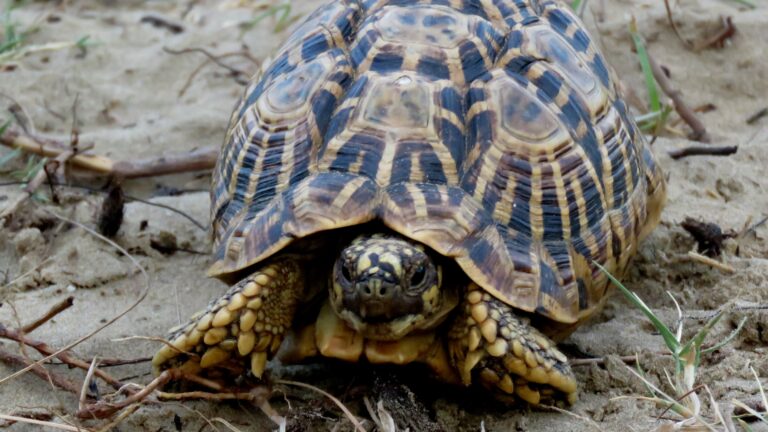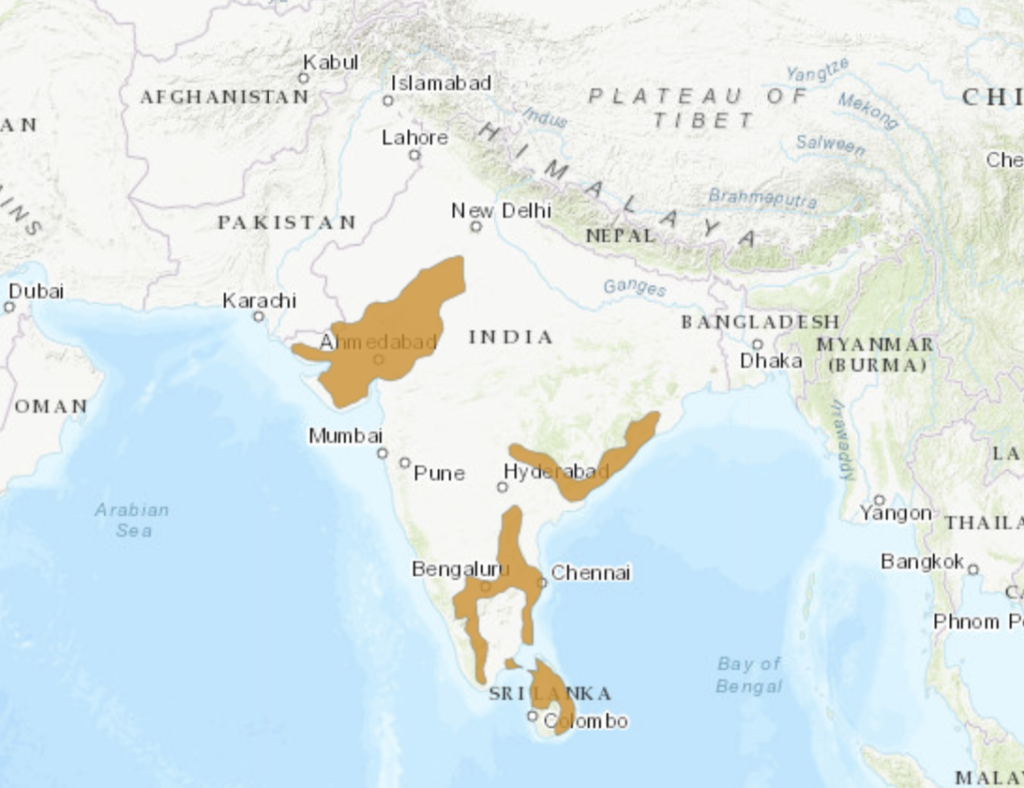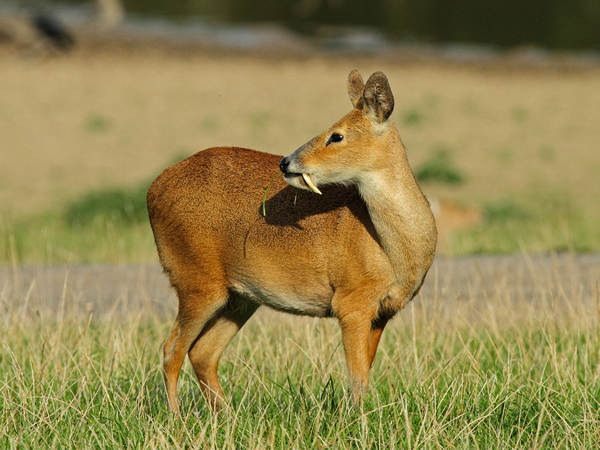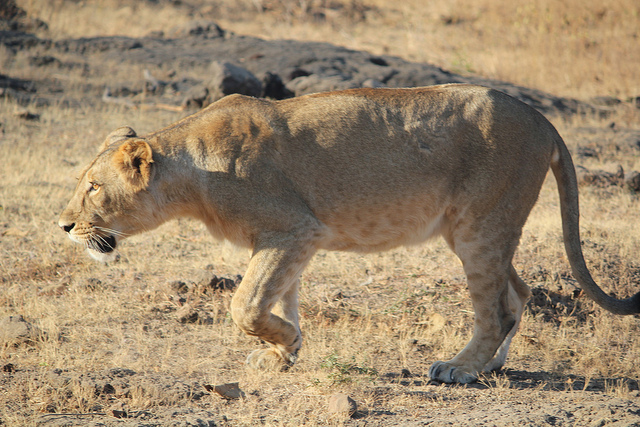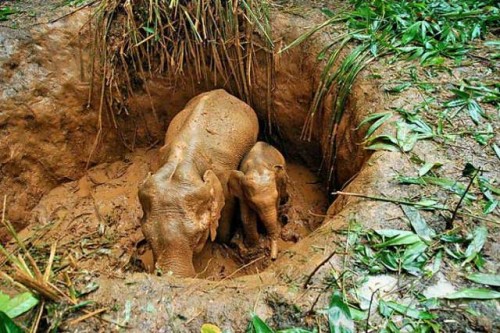The Indian Star Tortoise are found in two distinct geographical areas in India. Northwestern India (Gujarat, Rajasthan, and Madhya Pradesh) and eastern and southern India (Tamil Nadu, Andhra Pradesh, eastern Karnataka, Odisha). There is also a third population found in Sri Lanka.
The local environmental conditions play an important role in moulding the characteristics of a species and thus the tortoise found in Madhya Pradesh for example could be genetically slightly different from the tortoise found in Tamil Nadu. This genetic variation is the key to the species survival. However, new research has pointed out that the Indian Star Tortoise has lost its genetic diversity owing to illegal wildlife trade.
The star tortoise is traded in high numbers across South Asia and sold as exotic pets because of its beauty and relative ease of caring as a pet. Due to the illegal capture, trade and translocation through unscientific methods individuals from western habitats have intermingled with their southern cousins and even distant cousins from Sri Lanka. So much so that now the genetic variations that would have given the species a stronger chance of survival have been lost.
The study titled ‘Mitochondrial DNA and Distribution Modelling Evidenced the Lost Genetic Diversity and Wild-Residence of Star Tortoise, Geochelone Elegans (Testudines: Testudinidae) in India’ was published in an international journal in December 2022.
The researchers of the study say that the Star Tortoise – which is tagged as ‘Vulnerable’ in the Red list of threatened species – is facing twin challenges of threat to its habitat as well as the loss of genetic diversity.
The big threat of wildlife trade
The Indian star tortoise is said to be the most trafficked reptile in the world. Since 2019, it is listed under Appendix I of the CITES (Convention on International Trade in Endangered Species) list which means that international commercial trade of the species is banned. But despite the tougher international actions, the trade continues.
In India, data collated by the non-profit the Wildlife Protection Society of India shows that authorities seized 3,500 star tortoises in 24 incidents across 2020 and 2021 – after the CITES ban came into effect.
As per the Smuggling in India report 2020–21, the DRI’s (Directorate of Revenue Intelligence) most common wildlife and wildlife products that were seized from being smuggled out of India are ivory, turtles and tortoises, especially the Indian star tortoise. It is supplied from trade hubs in Karnataka, Andhra Pradesh, Gujarat, and Tamil Nadu, to Thailand, Singapore, and Malaysia, primarily by air, reports Mongabay India.
Packed in suitcases, vegetable cartons and bags, the tortoise legs and head are taped to avoid movement. Most of them die in transition because of the stress and the suffocation.
But when seizures happen and the traders are nabbed, the rescued tortoises are often far away from their local habitat. Even if they are released in the wild, there is a greater chance of mingling with the local population leading to genetic fusing.
Further Reading: Endangered Star Tortoise Rescued and Released with Satellite Tag
Why is genetic diversity so important, especially for an endangered species?
Genetic variation or genetic diversity is the raw material to the evolution of any species. Without variation, a species cannot mould or adapt itself to the changing environmental circumstances and may not survive in that particular landscape. This is why, if a population in Andhra Pradesh was wiped out because of climate change, it could not be replaced by a population from Rajasthan as the genetic traits to be surviving in the landscape would be missing.
Genetic variation also ensures the survival of a species as a whole. For example, if a disease were to spread in a population of the tortoise, some tortoise may have genetic resistance to the disease and may survive. If there is no genetic variation, all of the population will not be able to fight the disease and might perish.
For endangered and threatened species whose numbers are anyhow very low, this becomes a great threat and pushes them further towards species extinction.
“Our study calls for a proper conservation strategy to combat the fragmented distribution and explicitly recommends intensive genetic screening of founder individuals or isolated adult colonies by implementing scientific breeding,” Shantanu Kundu, a researcher with Professor Hyun-Woo Kim Lab, Pukyong National University, South Korea told The Hindu.
Fragmented habitat
The authors of the study also found that 10% of the habitat range of the Indian star tortoise is suitable for habitation. However, these areas are hugely impacted by human interference. Rapid development, urbanisation and conversion of land to agricultural land has fragmented and deteriorated the habitat of the tortoise.
“Areas within the states of Gujarat and Rajasthan, followed by Tamil Nadu, Karnataka, and Andhra Pradesh, suffer the most with the highest levels of habitat fragmentation due to the rapid development of urbanization and croplands,” write the study authors.
How can genetic diversity be ensured for the Indian star tortoise?
The scientists recommend screening to identify founder individuals or colonies of tortoises that have not mingled with populations from other regions. These populations can be carefully protected to preserve maximum genetic diversity.
“Current research recommends genetic screening to identify founder individuals or isolated adult colonies, in the wild or captive for scientific breeding, to preserve maximum genetic diversity, avoid inbreeding depression, and support the successful reintroduction of captively bred offspring to the wild to recover the lost heterozygosity of G. elegans,” the publication added.

